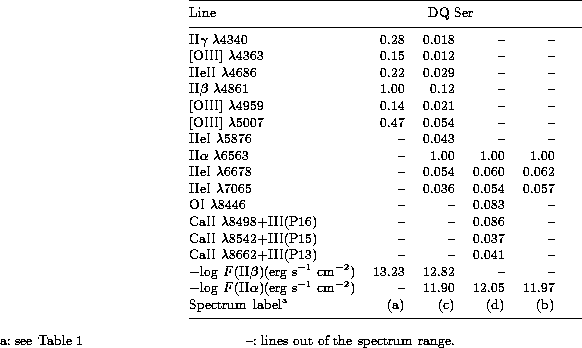The observations were carried out using the facilities of
Laboratório Nacional de Astrofísica (LNA/CNPq), in southeast
Brazil. The spectroscopic observations (Table 1) were obtained
with a Boller & Chivens Cassegrain spectrograph attached to the 1.6-m
telescope. Two gratings with 300 and 900 lines/mm were used, which
provide about 10 Å and 3.5 Å resolution (as derived from the FWHM
of the lines from comparison lamps). The detector used was a
GEC P88230 CCD (![]() , 22.5
, 22.5 ![]() m/pixel) with
UV coating. In the near infrared we used a OG550 filter in order to cut
the blue portion of the second order spectrum.
m/pixel) with
UV coating. In the near infrared we used a OG550 filter in order to cut
the blue portion of the second order spectrum.
The spectra were extracted using the Image Reduction and Analysis
Facility (IRAF![]() ) software installed at the SUN
workstations of the Astrophysics Division at INPE. Spectrophotometric
standard stars from the lists of Stone & Baldwin (1983) and
Taylor
(1984) were observed each night to flux calibrate the spectra. The
integrated line fluxes of DQ Ser were computed using the "splot'' task
of IRAF, and are presented in Table 3 (click here). The line fluxes were not
corrected for reddening and we estimate the absolute fluxes to be
accurate to about 30%, while relative line fluxes being more
accurate.
) software installed at the SUN
workstations of the Astrophysics Division at INPE. Spectrophotometric
standard stars from the lists of Stone & Baldwin (1983) and
Taylor
(1984) were observed each night to flux calibrate the spectra. The
integrated line fluxes of DQ Ser were computed using the "splot'' task
of IRAF, and are presented in Table 3 (click here). The line fluxes were not
corrected for reddening and we estimate the absolute fluxes to be
accurate to about 30%, while relative line fluxes being more
accurate.

Figure 2: Finding chart for DQ Ser a) and DT Ser b).
These images
were obtained in the I filter and cover about ![]() arcmin. North
is up and east is right
arcmin. North
is up and east is right
The UBVRI data were collected using the FOTRAP photometer at the 0.6-m Zeiss and 1.6-m Boller & Chivens telescopes. This photometer uses a high-speed rotating (1200 rpm) filter wheel which allows quasi-simultaneous photometry in 5 bands. The detector used was a thermoelectrically cooled Hamamatsu R943-02 photomultiplier operated in pulse counting mode.
The instrumental magnitudes were transformed to the ![]() system by observing standard stars in the E-regions
(Graham 1982). The
data obtained are shown in Table 2 (click here). The uncertainties (Cols.
7 to 11) take into account the errors due to photon noise in the
measurements and errors associated with the transformation to the
standard system. A more complete description of the procedures of
reduction, as well of the FOTRAP photometer and the photometric system,
can be found in Jablonski et al. (1994).
system by observing standard stars in the E-regions
(Graham 1982). The
data obtained are shown in Table 2 (click here). The uncertainties (Cols.
7 to 11) take into account the errors due to photon noise in the
measurements and errors associated with the transformation to the
standard system. A more complete description of the procedures of
reduction, as well of the FOTRAP photometer and the photometric system,
can be found in Jablonski et al. (1994).

Table 3: Observed lines fluxes of DQ Ser scaled to
H![]() =1.00 or H
=1.00 or H![]() = 1.00
= 1.00